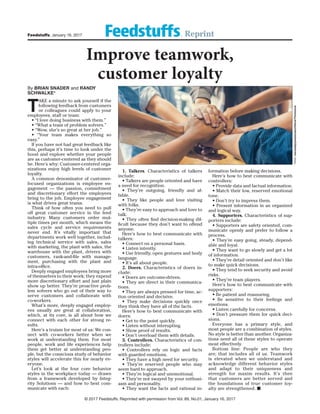More Related Content
Similar to FeedstuffsReprint_January 2017_pg 11.indd
Similar to FeedstuffsReprint_January 2017_pg 11.indd (20)
FeedstuffsReprint_January 2017_pg 11.indd
- 1. By BRIAN SNADER and RANDY
SCHWALKE*
T
AKE a minute to ask yourself if the
following feedback from customers
or colleagues could apply to your
employees, staff or team:
• “I love doing business with them.”
• “What a team of problem solvers.”
• “Wow, she’s so great at her job.”
• “Your team makes everything so
easy.”
If you have not had great feedback like
this, perhaps it’s time to look under the
hood and explore whether your people
are as customer-centered as they should
be. Here’s why: Customer-centered orga-
nizations enjoy high levels of customer
loyalty.
A common denominator of customer-
focused organizations is employee en-
gagement — the passion, commitment
and discretionary effort the employees
bring to the job. Employee engagement
is what drives great teams.
Think of how often you need to pull
off great customer service in the feed
industry. Many customers order mul-
tiple times per month, which means the
sales cycle and service requirements
never end. It’s vitally important that
departments work well together, includ-
ing technical service with sales, sales
with marketing, the plant with sales, the
warehouse with the plant, drivers with
customers, rank-and-file with manage-
ment, purchasing with the plant and
intra-office.
Deeply engaged employees bring more
of themselves to their work; they expend
more discretionary effort and just plain
show up better. They’re proactive prob-
lem solvers who go out of their way to
serve customers and collaborate with
co-workers.
What’s more, deeply engaged employ-
ees usually are great at collaboration,
which, at its core, is all about how we
connect with each other for strong re-
sults.
Here’s a truism for most of us: We con-
nect with co-workers better when we
work at understanding them. For most
people, work and life experiences help
them get better at understanding peo-
ple, but the conscious study of behavior
styles will accelerate this for nearly ev-
eryone.
Let’s look at the four core behavior
styles in the workplace today — drawn
from a framework developed by Integ-
rity Solutions — and how to best com-
municate with each:
ReprintFeedstuffs, January 16, 2017
© 2017 Feedstuffs. Reprinted with permission from Vol. 89, No.01, January 16, 2017
Improve teamwork,
customer loyalty
1. Talkers. Characteristics of talkers
include:
• Talkers are people oriented and have
a need for recognition.
• They’re outgoing, friendly and af-
fable.
• They like people and love visiting
with folks.
• They’re easy to approach and love to
talk.
• They often find decision-making dif-
ficult because they don’t want to offend
anyone.
Here’s how to best communicate with
talkers:
• Connect on a personal basis.
• Listen intently.
• Use friendly, open gestures and body
language.
• It’s all about people.
2. Doers. Characteristics of doers in-
clude:
• Doers are outcome-driven.
• They are direct in their communica-
tions.
• They are always pressed for time, ac-
tion oriented and decisive.
• They make decisions quickly once
they think they have all of the facts.
Here’s how to best communicate with
doers:
• Get to the point quickly.
• Listen without interupting.
• Show proof of results.
• Don’t overload them with details.
3. Controllers. Characteristics of con-
trollers include:
• Controllers rely on logic and facts
with guarded emotions.
• They have a high need for security.
• They’re reserved people who may
seem hard to approach.
• They’re logical and unemotional.
• They’re not swayed by your enthusi-
asm and personality.
• They want the facts and rational in-
formation before making decisions.
Here’s how to best communicate with
controllers:
• Provide data and factual information.
• Match their low, reserved emotional
tone.
• Don’t try to impress them.
• Present information in an organized
and logical way.
4. Supporters. Characteristics of sup-
porters include:
• Supporters are safety oriented, com-
municate openly and prefer to follow a
process.
• They’re easy going, steady, depend-
able and loyal.
• They want to go slowly and get a lot
of information.
• They’re detail oriented and don’t like
to make quick decisions.
• They tend to seek security and avoid
risks.
• They’re team players.
Here’s how to best communicate with
supporters:
• Be patient and reassuring.
• Be sensitive to their feelings and
emotions.
• Listen carefully for concerns.
• Don’t pressure them for quick deci-
sions.
Everyone has a primary style, and
most people are a combination of styles.
No style is better than another. Organiza-
tions need all of these styles to operate
most effectively.
Bottom line: People are who they
are; that includes all of us. Teamwork
is elevated when we understand and
acknowledge different behavior styles
and adapt to their uniqueness and
strength for maxim results. It’s then
that customers are better served and
the foundations of true customer loy-
alty are strengthened. ■
Photo:veerasakpiyawatanakul/iStock/Thinkstock.
